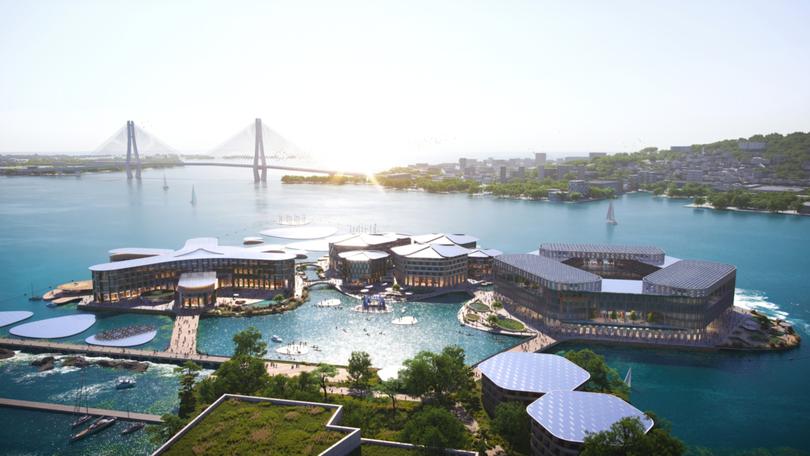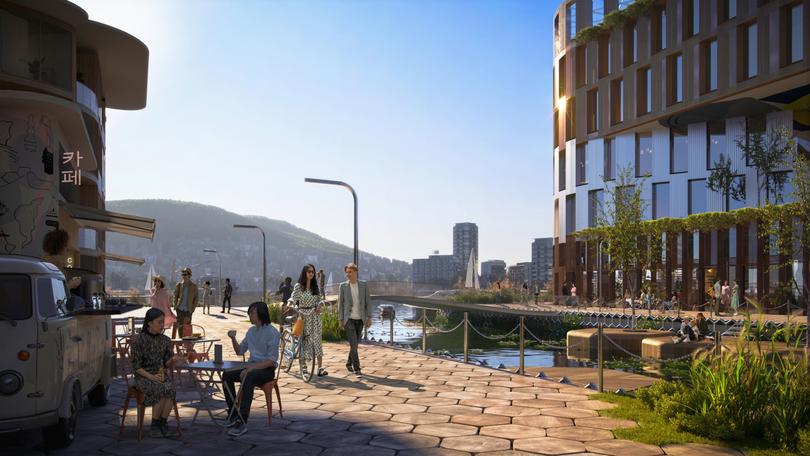The New York Times: Are floating cities the solution to rising seas?

Worldwide, rising sea levels and increasing urbanization represent a formula for disaster, with more and more people seeking to live on land that will, at some point, be swallowed up by the sea. But a futuristic-sounding solution — the construction of full cities on top of the water — is poised to become a reality.
One project in particular, off Busan, South Korea, is roping in a combination of high and low technology to create a large-scale, on-water town, which will be able to house more than 10,000 people.
Strictly defined, floating communities already exist in the Netherlands, Thailand and elsewhere in Southeast Asia. But these are typically clusters of houseboats moored close to one another. What sets the new concepts apart is a matter of scale. Rather than comprising an agglomeration of smaller vessels, each of these cities is designed to be built on enormous concrete platforms suspended on the water.
Sign up to The Nightly's newsletters.
Get the first look at the digital newspaper, curated daily stories and breaking headlines delivered to your inbox.
By continuing you agree to our Terms and Privacy Policy.How does such a large form float?
“The physics is very easy,” said Koen Olthuis, the founder of the Dutch architectural firm Waterstudio, who designed a floating development in the Maldives that has received a great deal of attention.
“A block of concrete will sink,” Olthuis added, speaking on the phone from the Netherlands. “But if you shape it into a box, then it floats. It’s Archimedes. The amount of volume you push away is equal to the weight of the displaced water.” Think of aircraft carriers.
The floating city in development off Busan is coming together through the collaborative efforts of the United Nations Human Settlements Program, known as UN-Habitat; the architecture firm BIG (Bjarke Ingels Group); and technology company Oceanix. Founded in 2018 by Itai Madamombe and Marc Collins Chen, Oceanix, which is based in New York City, designs and builds floating infrastructure for people to live and work sustainably on the ocean. (Some 90% of cities are coastal and hence can be vulnerable to sea level rise, according to UN-Habitat.)

When cities need to expand to accommodate more people, many resort to land reclamation, using large amounts of rock or cement, then filling in with clay and dirt until the ground is sufficiently high to build on. According to Madamombe, this is not sustainable.
“They are essentially dumping debris and other things into the ocean to create new land, which has a lot of problems,” she said.
The floating city in the works off the coast of South Korea, Oceanix Busan, is relying on a series of connected floating platforms that are designed to initially cover 6.3 hectares (about 15.6 acres) and house about 12,000 people. The community will be linked to the land by a bridge, and each platform will be anchored to the seabed. The infrastructure will handle power, water, waste and some food. Madamombe said the goal is not only self-sufficiency, but also, if possible, the ability to produce enough energy to give back to the nearby community.
“This is an extension of a city,” she said.
Construction on the modular platforms is currently scheduled to begin in South Korea by the end of the year. The platforms will then be towed to the site and assembled.
“This allows us to build as many of these as quickly as possible,” Madamombe said. She added that the structure is infinitely expandable, and the city could eventually house 150,000.
The project is scheduled to be completed by 2028. “We are also pursuing other diverse floating infrastructure projects that we will be announcing in the near future,” Madamombe said.
Busan’s floating city is centred on the feat of building on water, with less attention paid to the design of individual buildings.
“We were more making sure that the concepts that we developed for the city infrastructure could house a great degree of variation of different kinds of architecture,” said Daniel Sundlin, a partner at BIG. (The firm also developed a community of 72 floating apartments in Copenhagen, Denmark, near a deserted island that had served as a shipyard, as part of a project called Urban Rigger.)
The shape of the Busan platforms, basically rounded hexagons, keeps them stable; they won’t rock with every wave, as a houseboat would. BIG also worked with the Massachusetts Institute of Technology and marine engineering firms to make sure the platforms could withstand the waves and winds associated with hurricanes.
“We have been conscious about the scale of the buildings, and also the materials we use to keep the weight as light as possible,” Sundlin said. “Treated wood is a great material in that it is very lightweight.”
“Steel is lightweight,” he added, as compared with concrete or masonry.
These structures are also unique in their ability to increase biodiversity and the ecological health of the harbours in which they are anchored, by providing places for oysters and mussels, for example, to grow. “This kind of floating structure attracts life in the ocean and essentially helps to restore ecology,” Sundlin said.
Floating cities are the Wild West in terms of international regulations and standards. So projects like Busan are setting those standards, with the help of the United Nations. Naomi Hoogervorst, the program management officer of the Planning, Finance and Economy Section of UN-Habitat, said it is the organization’s role to make sure sustainable development goals are implemented at all levels.
Hoogervorst said Busan was chosen because it strongly embraces technological innovations, especially in marine engineering, and because South Korea is promoting smart marine cities in general. Madamombe added, “The mayor is dedicated to making Busan the No. 1 smart marine city,” so they are able to move more quickly than people working on similar projects in other parts of the world.
“I think people see it as this far-fetched, futuristic thing,” Sundlin said. But, he added, floating markets, houseboats and houses on stilts have been around “since the beginning of civilization.” He noted that these forms of architecture are still “a very common way of living next to or on top of water.”
This article originally appeared in The New York Times.
© 2024 The New York Times Company
Originally published on The New York Times
